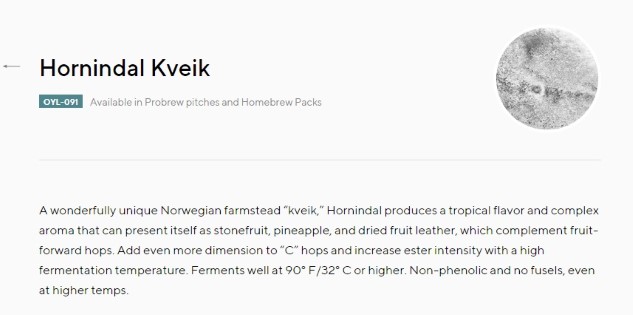Kveik: The Little Yeast Strain That Could
Photos via Omega Yeast/Burnt City Brewing Drink Features craft beer
If you’ve been paying attention to the beer landscape in the last few years, you’ve almost certainly seen the word “Kveik” pop up at one of your favorite bars or taprooms, possibly alongside words like “Norwegian farmhouse ale.” These words, however, like so many other labels in the beer world, don’t necessarily summon an accurate expectation from the drinker of what a “Kveik beer” will be like. In particular, “farmhouse ale” might put you in the mindset of a classical, Franco-Belgian saison, but Kveik is something else entirely. In reality, this little-known, traditional ale yeast has proven incredibly adaptable to modern brewing styles, and has the potential to be useful across a wide range of styles for both homebrewers and professionals.
In short, the word “Kveik” simply means “yeast” in the Norwegian language, meaning that referring to it as “Kveik yeast” may be a bit redundant. But this is not a standard strain of saccharomyces cerevisiae, of the sort you may have been purchasing from a homebrew shop for the past 20 years. Although Kveik is indeed Saccharomyces rather than wild brettanomyces, it differentiates itself with properties that make it strange and unique.
Take fermentation, for instance. Kveik has the distinction of being viable in an incredibly wide range of fermentation temperatures, which sets it apart from comparable ale yeasts. In particular, it can ferment much, much warmer than other varietals, at temperatures that exceed 100 degrees, while apparently not struggling at all in terms of viability. Stranger still, though, is the fact that swings in temperature of fermentation don’t seem to particularly affect the flavor profile of Kveik beers—it produces beers that taste more or less the same when fermented at 70 degrees or 100 degrees. Those who have any brewing experience at all know that this sounds almost impossible, as most of the popular commercial ale yeast strains, such as Sierra Nevada’s famous Chico strain, behave very differently when the temperature raises even 5 or 10 degrees. Not so with Kveik, and this versatility has a lot of brewers very excited. At the same time, it represents perhaps an even more exciting find for homebrewers, who may lack means of accurate temperature gauging or precise temperature control during fermentation.
But it gets even weirder. Kveik yeast also naturally dries into flakes, making it easy to store without liquid, and making inoculation potentially as simple as just adding some dried Kveik back into a carboy of cooled wort. It also flocculates heavily, meaning the yeast drops out of suspension, allowing brewers to separate it easily, and making it easy to produce either clear or hazy beers as desired. Coupled with a relatively mild, somewhat fruit-forward flavor profile, it makes Kveik the hidden Swiss army knife of ale yeasts. In fact, its properties are potentially so valuable, it’s a bit of a wonder if took so long for this old-style yeast to be discovered and co-opted by U.S. brewers.
Now, though, it’s clear that Kveik has arrived, in a variety of different strains. The yeast is having a moment at small U.S. craft brewers from coast to coast, and will be celebrated by more than 30 breweries at the inaugural Kveik Fest in Chicago on Saturday, Sept. 7. Sponsored by Chicago’s Omega Yeast, who were among the first to supply Kveik to U.S. breweries, and organized by head brewer Ben Saller of Burnt City Brewing, the event will be hosted at brewery collective District Brew Yards (which houses Burnt City), with all-you-can-drink Kveik tickets going for $75 a pop. Speaking with Paste, Saller described himself as an enthusiastic Kveik fan, who has used the yeast strain to make quite a few very different beer styles at Burnt City in the last few years.
“The different strains of Kveik yield different flavors, which makes some of them perfect fits for specific styles of beer,” Saller said. “In general they’re fruity, but without banana esters or clove-like phenolics that you’d get from Belgian ale yeast. Some give citrus notes; others produce flavors that are more like pineapple or mango. These flavors are fairly subtle; they’re not strong enough that you can’t use Kveik strains for an imperial stout or barleywine, but I love how they accentuate hoppy beers or farmhouse styles.”
 One of the Kveik strains available from Omega Yeast in Chicago.
One of the Kveik strains available from Omega Yeast in Chicago.
Despite the “farmhouse” connotation, then, Kveik strains tend to be more similar in terms of the flavors they produce to American or British ale yeast strains, rather than Belgian ones, lacking the phenolic spice profile you get in many Belgian abbey ales or German styles such as hefeweizen. This being the U.S. market, where IPA is king, it naturally means that many craft breweries experimenting with Kveik have used the yeast to complement the citrus/tropical fruit flavors of modern hop varietals, but it also apparently plays quite nicely with brettanomyces in a mixed fermentation environment. That’s the constant refrain with Kveik: It’s both easy to use and endlessly adaptable, especially because it can ferment so warm.
“We do most of our Kveik fermentations at 95 degrees, which is about the temperature it is when we transfer wort into the fermenters,” Saller said. “The fermentation is so rapid and so active that it keeps the temperature up there. From what I’ve heard, the fruit character of Kveik is a little more muted at low temperatures, but the change isn’t big like in California ale yeast, where 80 degrees will give you all these phenolics.”
What you have in Kveik, then, is a particularly forgiving ale yeast strain, and one that can be used to produce the likes of both clear, West Coast-style IPA or hazy NE-IPA, which can be achieved via other methods such as active fermentation dry hopping. Saller has even used Kveik to ferment several imperial stouts and a barrel-aged barleywine—not necessarily because he’s seeking any particular yeast profile for those beers, but because there’s almost no reason not to use Kveik, when you’re not trying for a specific, historical yeast profile. After all: When it’s a fairly clean-fermenting ale yeast, and it tastes more or less the same across a wide temperature range, why not use it?
“The Kveik-type flavors don’t really come across in a meaningful way that I pick up on in the imperial stouts, when there are such big, roasty flavors happening,” he said. “But as far as I’m concerned, it’s a great neutral yeast for that style, so there’s no reason for me not to use it. Unless I was specifically trying to brew something like an English-style barleywine, I’d certainly consider using Kveik.”
At Kveik Fest, the full range of the yeast’s eclecticism will surely be on display, as breweries such as Burnt City, Solemn Oath, Off Color, Dovetail and 2nd Shift will show off what they were able to create using what until recently was Norway’s best kept secret. Even if there may have been some initial consumer hesitation in sampling beer with an unfamiliar label like “Kveik,” it would hardly be surprising now if this yeast is headed for the mainstream in the near future. Already, it’s available for commercial purchase from a number of providers around the U.S., and through several homebrewing suppliers as well. The future is looking pretty Kveik, if you ask us.
“A lot of local Chicago breweries were early in experimenting with Kveik because of Omega, who were one of the first to carry it, so this definitely feels like a hotbed for Kveik brewing,” Saller said. “Word probably spread here a little faster. But half the breweries attending Kveik Fest are coming from out of state, so it’s certainly spread around the country as well. Last week I saw a post from a guy in Nigeria who was looking to get some Kveik yeast for his own brewing experiments, so that’s pretty cool, right?”
Jim Vorel is a Paste staff writer and resident beer guru. You can follow him on Twitter for more drink writing.